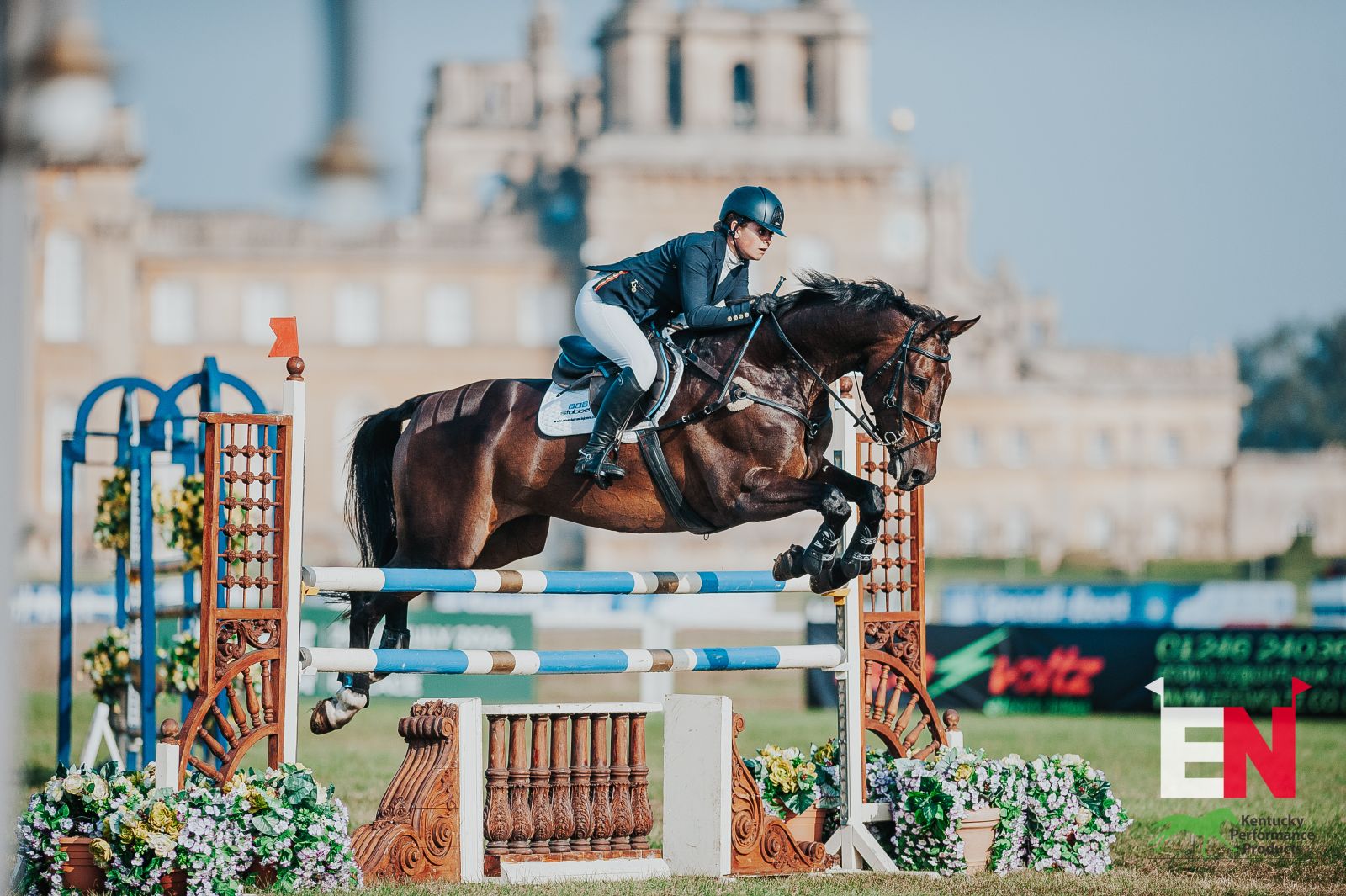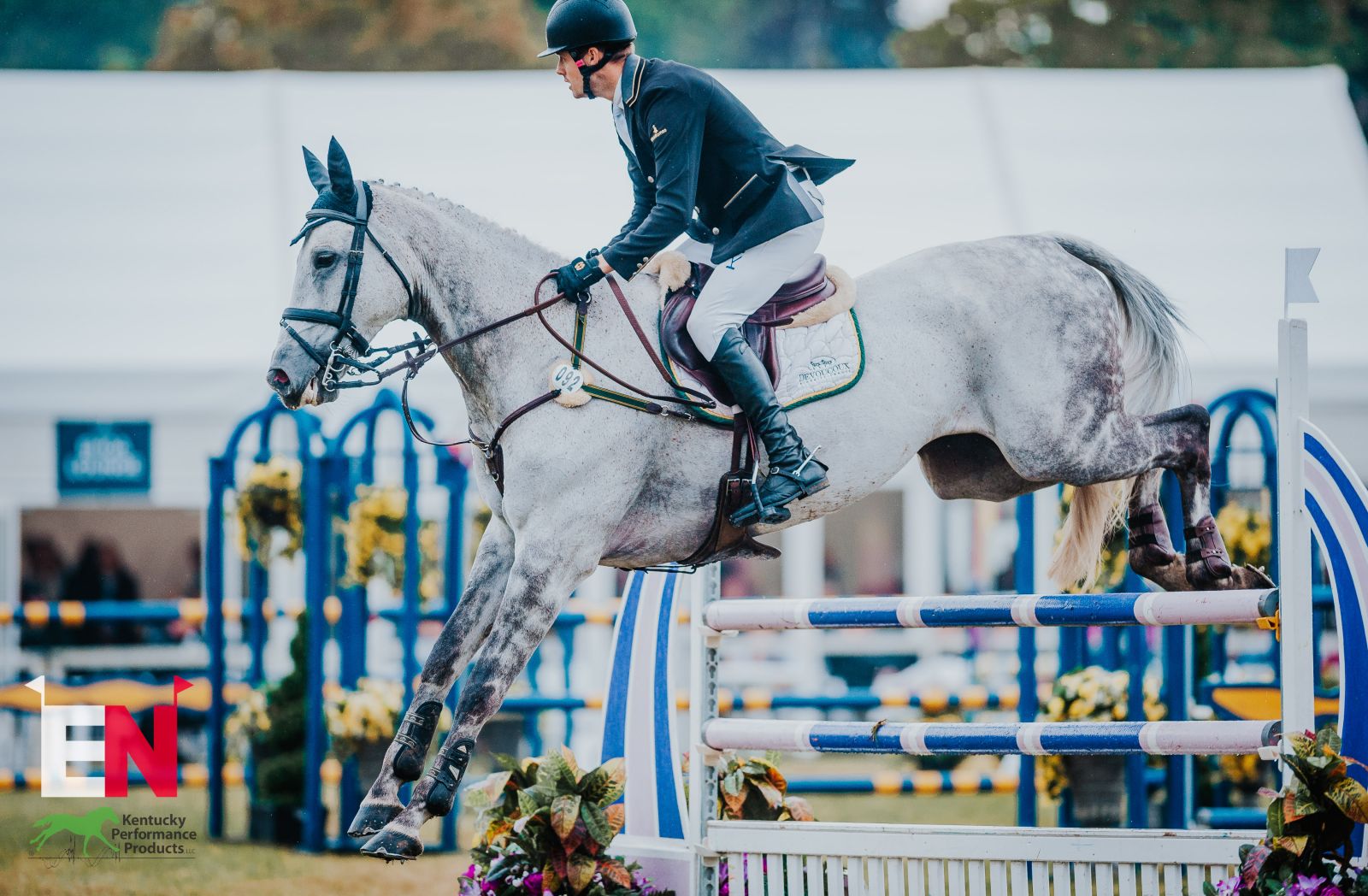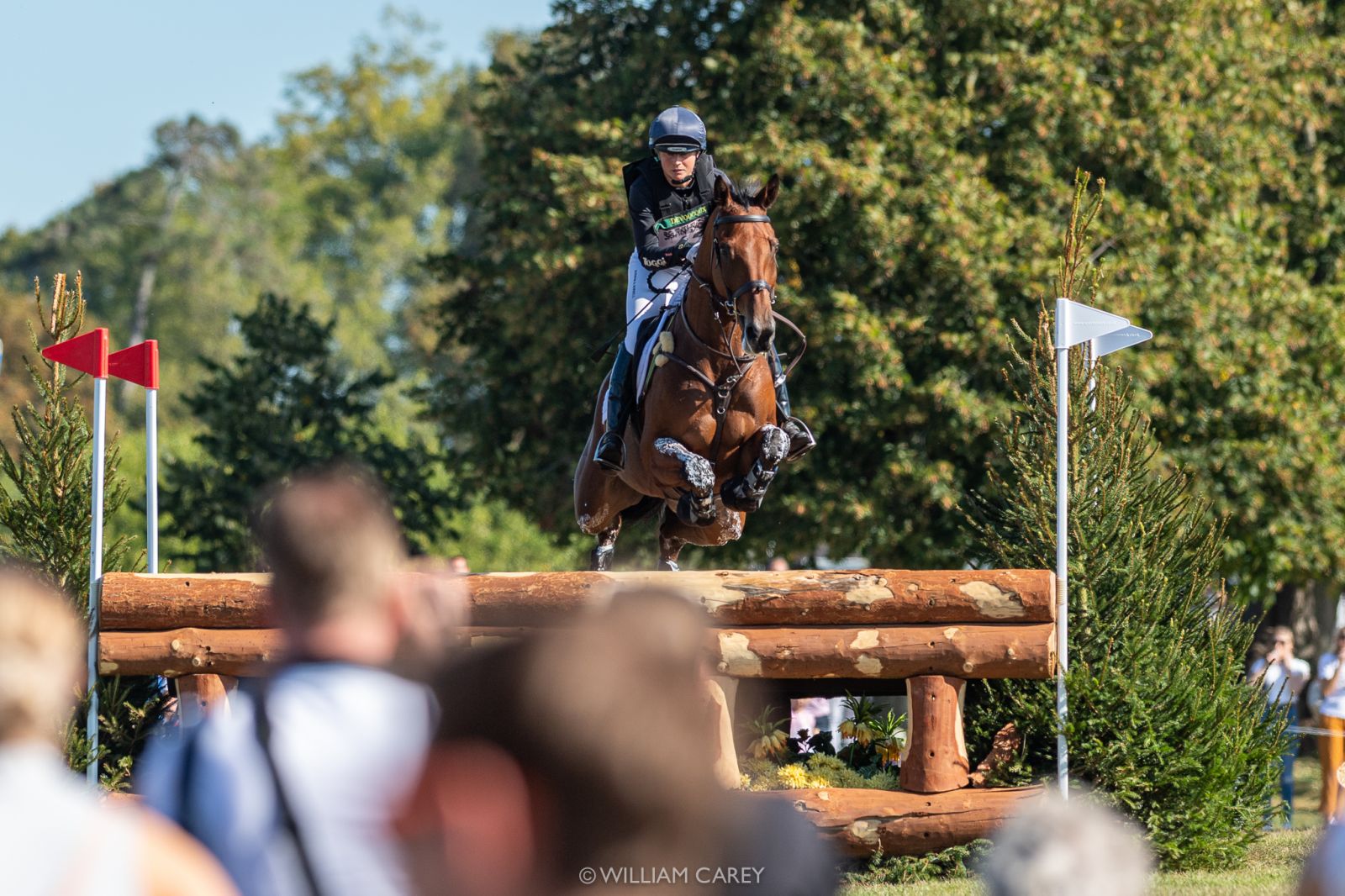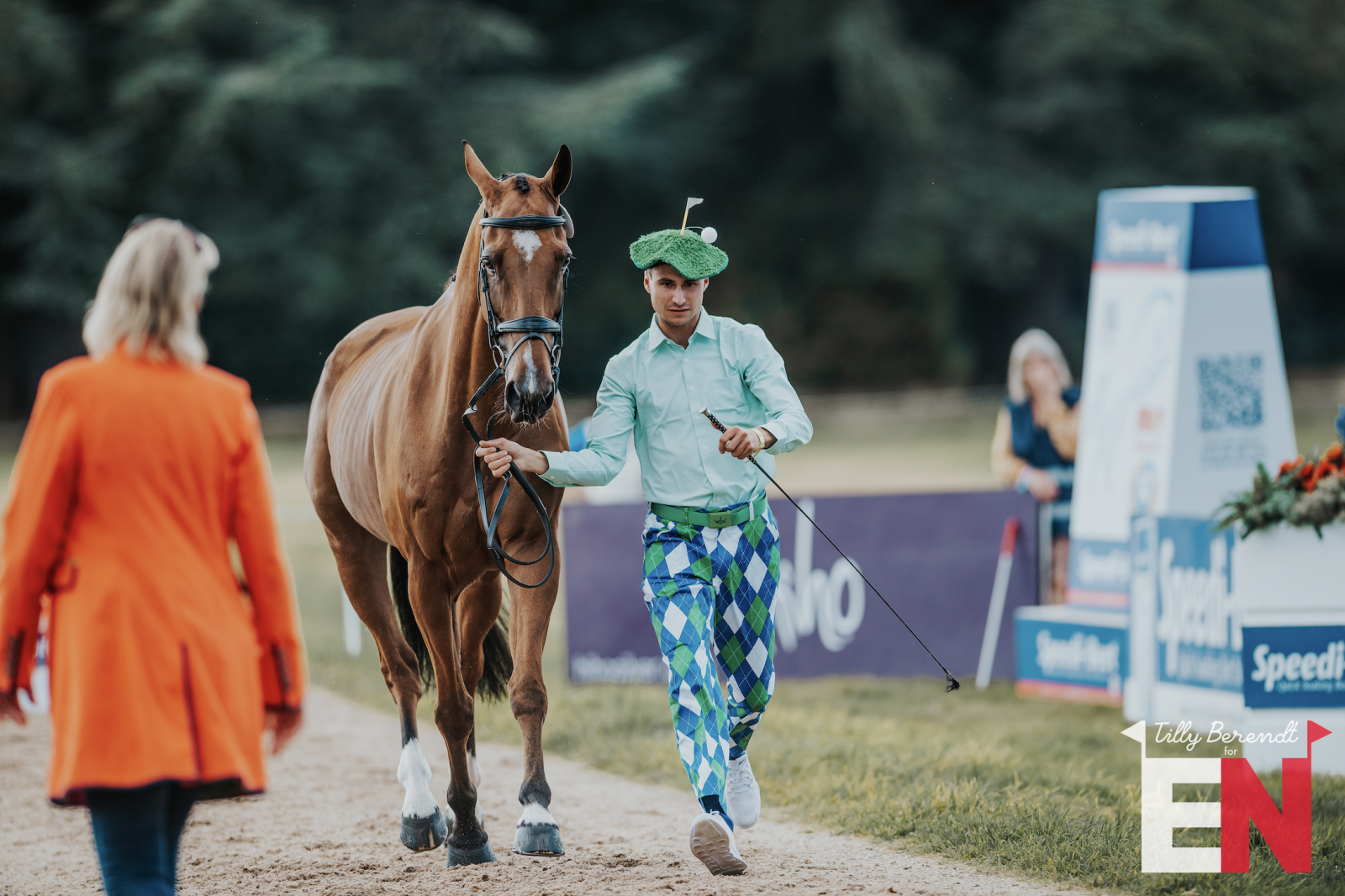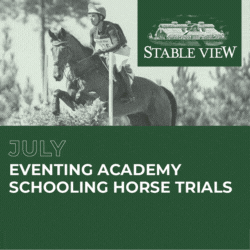
Oliver Townend meets the influential lake crossing for the first time aboard Cooley Rosalent. Photo by Tilly Berendt.
It’s been a Blenheim for the books this week, and after yesterday’s surprise-filled CCI4*-L cross-country, the CCI4*-S for eight- and nine-year-olds certainly didn’t disappoint in the drama stakes, either. Of the 90 competitors who came forward for today’s cross-country, 73 went on to finish, and 60 did so without jumping penalties — an 81% completion rate and a 67% clear rate. On paper, that’s generous — and should be, arguably, for these inexperienced, developing horses — but there was still change aplenty across the leaderboard, with the time proving achingly difficult to catch and a number of very good horses and riders picking up penalties along the way, particularly at the main water complex at 10abc, which saw 18 competitors run into trouble, and the first lake crossing at 8ab, which added penalties to the score cards of 10 competitors.
But before all that drama really kicked off, there was a bright light: six horses in, and with just two clear rounds logged in that time, Piggy March left the startbox with the eight-year-old Brookfield Future News, whose only previous Advanced run, in the eight- and nine-year-old class at Aston-le-Walls, had seen him top the leaderboard. But even with that under his belt, he’s arguably one of the least experienced in his field. Nevertheless, he crossed the course as though it had been built just for him, not just delivering a clear, but doing so five seconds inside the time.
Would that mean that other, more seasoned horses would join them en masse in the zero faults club? Not at all — until the latter stages of the day, when one horse would join them, becoming the only competitor in the class to finish on their dressage score.
That was, of course, overnight leader Cooley Rosalent, ridden by Oliver Townend.
“She’s incredible,” says Oliver. “We’ve always thought she was exceptional — we’ve had her since she was four years old, and she’s been special since the word go. I’ve been lucky enough to produce her, but in all honesty, most people could have produced her, because she’s very straightforward, exceptionally talented, and finds everything very easy. She wants to do it, probably even more than I do sometimes! She’s very keen and enthusiastic, and it’s very nice to go around a course with [a horse with its] ears pricked and a lot of blood that’s taking you places.”
Unlike Brookfield Future News, with his eight International cross-country runs, Cooley Rosalent has fifteen to her name — and that mileage showed in how capably she ran to the minute markers, finishing easily right on the 6:54 optimum time.
“She found it, as always, very comfortable,” says Oliver. “But the course, in general, was extremely tough for an eight- and nine-year-old class, which I think it should be — it’s our eight and nine year old championship, and it was a fair course, but at the same time, you definitely don’t want to be coming here on anything that’s even half green, because even for the ones that have enough mileage, it’s definitely a big step up for them.”
One of the holes in ‘Rosie’s’ belt? A five-star debut — a very rare accolade for a horse to bring to this class. She stepped up at Luhmühlen this year, finishing 27th after gaining an education, rather than truly putting up a fight, in each of the three phases — and that experience, Oliver says, has been huge for her.
“She went to Luhmühlen, and it would have been very easy to take her to Bramham and win, but my idea was that at the places we’re aiming her, she needs to come across as many people and atmosphere as much as possible,” he says. “We wanted to know how she coped with it, and what we needed to do from a management point of view and an educational point of view for the future. She wasn’t going to Luhmühlen to win; she was going to see people, and umbrellas, and arenas. But that mileage has been absolutely second to none, and then when you bring her to a place like Blenheim, she felt like a much older horse going around there.”

Piggy March and Brookfield Future News. Photo by Tilly Berendt.
Second-placed Piggy March was the picture of pure joy after crossing the finish line with that early, influential round with Brookfield Future News behind her — and rightly so. As one of the youngest and most inexperienced horses in the field, he was also the fastest by a margin of six seconds, and proved that his rider’s long-held belief in him was always well-founded.
“He was bloody brilliant — just amazing!” says Piggy. “And I’m just so excited because he’s everything that I’ve thought he’d be from the age of six. He’s a bigger blood horse, so he’s not always been the fanciest — he’s come second quite a lot, but I’ve always believed in him, and he’s been one of my favourites. Quite a few people, because he’s a bit chunky, have said, ‘oh, he might not have the quality’, but I’ve said all along, ‘you have no idea what this is underneath the bonnet!'”
‘Matthew’s’ low mileage isn’t just down to his age — it was also a tactical call on the part of Piggy, who believed a less-is-more approach would best set the horse up for a bright future.
“He’s probably run in four or five events this year, because he was amazing at Le Lion last year, and I know he’s a five-star horse,” she says. “The owners have just been brilliant, because I just said, ‘I don’t want to do masses — I don’t want to just run him for the sake of running. Can this be his target, and I’ll just start him at Aston Advanced, and if he’s what he feels like he’s going to be, I really wouldn’t do much more — he could do an OI and then go to Blenheim.’ Thankfully, they trusted me, and he came out feeling like he just was on his job.”
The pair had begun their week in joint second place with Oliver and Rosie; they then stepped into overnight second on their own after yesterday’s showjumping. That phase saw dressage leaders Tom McEwen and MHS Brown Jack eliminated for tipping five rails, and while Piggy, like Oliver, jumped a clear round, she ended up adding two seconds, or 0.8 time penalties, to her score card when Matthew slipped in the dewy morning grass and lost time regaining his footing and balance. That slip might seem like it cost them the win — but actually, as they were so swift today, they’d have been relegated to second regardless for being further from the optimum time.
“It’s absolutely brilliant — obviously, right at the minute I’m sort of like, ‘oh god, that was annoying to have my slips in the showjumping’, but who cares in the grand scheme of things,” says Piggy — interviewed, at that point, before Oliver’s round. “He’s eight, and he’s so exciting — I think it’s exactly what we all do this for. The days and moments like that; you give the owners a hug and we’re all buzzing, because it’s a horse we’ve done the journey with and we’ve always believed in, and to then get on a stage and do that… it’s cool!”

Pure joy: Piggy March crosses the finish with Brookfield Future News. Photo by Tilly Berendt.
Though Piggy had all faith that John and Chloe Perry and Alison Swinburn’s gelding would thrive at Blenheim, she also went into today’s finale with the pragmatism of someone who’s produced plenty of young horses, and knows all too well that they’re always an unknown quantity until they’ve actually got stuck into their biggest challenges.
“I was hoping it wouldn’t be too much,” she says, “but there’s a couple of times that he looked, especially coming down to the waters — and he’s not funny with water at all. But I think with people, with lots going on, this is more of an occasion — and that big main water crossing is quite an eyeful. My little Halo did the same thing last year; coming here for the first time, they just come down to it and have a little bit of a like, ‘Is that for real? What are we about to jump into across here?’ And so I was hoping he would just take that in his stride.”
Something that’s helped prepare him for the big atmosphere of Blenheim, she thinks, is the variety she’s injected into his education.
“I even took him showjumping a couple of times. We went to Bolesworth, because I had to go with one of our young breeding horses, and I thought, because he’s not running very much I’ll give him a different experience with absolutely no pressure, but with speakers, music, a bit of razz, different type of course-building — it’s square, it’s bigger, and there’s quite a lot to look at. I think that will have done him a good bit of good.”

Tim Price and Jarillo. Photo by Tilly Berendt.
Tim Price has been a particularly busy boy this week, with three exciting up-and-comers contesting this class. His first, Viscount Viktor, was among the earliest rounds of the day; he picked up 20 penalties at the back water en route to 65th place, and his last, the exquisite Chio 20, ran clear but steadily to move from the top ten down to 18th with 15.6 time penalties.
The star of the show, though, in his string at least? The nine-year-old Jarillo, who has stayed in the top ten all week, and maintained his overnight third place by adding just 2 time penalties today.
“He doesn’t make many mistakes,” says Tim of the Dutch-bred gelding, who he rides for Lucy Allison, Frances Stead, and James and Rachel Good. “He’s just a really classy little horse, and he keeps trying very hard. It’s quite rare for such a careful horse to be so brave on cross-country, and today was a big test and with a lot of different things. He’s done one four-short before in Ireland, but this was definitely a step along, being what it is, and he dealt with it all really well.”
All three horses, Tim hopes, will do big things in the years to come — but Jarillo, particularly, has a certain something about him.
“He’s so nice to ride,” he says. “I’m very lucky, because he can do a lot of different things. He’s quirky; he’s horse-shy, and he’s a bit sharp and he has his little idiosyncrasies, but ultimately, he’s looking at the fence, at the profile, at the ground, and he’s very careful. Some horses have got something special with the way they deal with it all. He’s one of those.”
The course, Tim explains, was a big ask for these inexperienced horses, and gave plenty of opportunities for educational moments — whether they were the productive kind, as far as the leaderboard goes, or not.
“It came quite thick and fast after just a couple of minutes, so it was quite a bit for them to look at, first with the water crossing, and then the big water at the back. So you saw quite a few have a green moment that they either paid for or got away with — but he was good, and he just grew into the course as we went and came home full of running.”

Caroline Harris and D. Day brave the rain to threaten the podium. Photo by Tilly Berendt.
Caroline Harris has been always believed in D. Day, but this season, she’s giving the rest of us plenty of reason to buy into the dream, too. Despite the very nearly impossible conditions of the spring season, he finished third in a very tough CCI4*-S at Chatsworth, and today, he took fourth place in this class, putting just 2.8 time penalties on his score sheet in the heaviest of the afternoon’s rain.
“He was really, really super,” says Caroline. “I tried to go as quick as I could, but it’s a bit slippery now that it’s rained a bit. He made it feel very, very easy, though; I’m so lucky to have him. He’s very clever. I’ve never actually ridden a horse quite like him — all he wants to do is please, and do his absolute best, and he’s such a quick thinker.”

Selina Milnes and Cooley Snapchat. Photo by Tilly Berendt.
Selina Milnes and Cooley Snapchat made their first big bid for the sporting spotlight at Bramham this year, where they handily won the tough CCI4*-S class, and it was that experience gained that enabled the nine-year-old to improve upon last year’s result here — a fifteenth place finish in his four-star debut — to finish fifth, picking up 4.4 time penalties on course to add to their dressage score of 29.4.
“He just took everything in his stride — we didn’t have one scary moment,” says Selina. “He was good through the top water, which they’ve been going a bit green at, but I probably wasted a little bit of time getting to the first water because I thought we need to stay out, but he was really good. He jumped round here last year as an eight year old without the pressure, and this year I thought, ‘come on then, let’s have a crack.’ I ride probably better under pressure, because I’m more forward, and he’s really stepped up this week.”

Tom Jackson and Plot Twist B. Photo by Tilly Berendt.
The influence of the course allowed for some major climbs up the leaderboard, and one of the most significant of those was that of Ireland’s Padraig McCarthy and Pomp N Circumstance, who executed a weeklong climb from 35th to sixth after adding just 4 time penalties, and nothing at all in yesterday’s showjumping, to their first-phase score of 31.8. Similarly, Tom Jackson and Plot Twist B were able to climb from 27th to seventh, beginning the week on a score of 30.5, tipping a pole yesterday, and then making light work of the course today with one of the fastest rounds of the day and just 1.6 time penalties.

Vittoria Panizzon and DHI Jackpot. Photo by Tilly Berendt.
Italy’s Vittoria Panizzon took eighth place with the nine-year-old DHI Jackpot, who nipped around with 7.2 time penalties to add to his first-phase score of 29, completing a climb from 14th place. This is just his third four-star run, though in a field such as this one, that still counts as reasonably hefty experience to bring to the party.
“Maybe he’s done a little more this year than some of the other horses, but I saw quite a few look a bit green this morning, and I’m delighted he wasn’t,” says Vittoria. “He was completely at ease with all of it. I’d have liked to be a little bit quicker, but it’s the first time he’s seen more crowds. He’s done a few four-stars, but this is the first one that’s a big party, so I just wanted to make sure that we focused on the jumps.”
Part of bringing young horses to big events such as this, Vittoria explains, is learning what you can do, and how you can hone the plan of action, in the future.
“To be honest, he’s got such a long stride, I could have taken a few more strides out in some combinations. But you feel a bit presumptuous thinking that when you haven’t seen anyone do that all day,” she says. “But that hollow [13AB], at which everyone I know of did four, that four was very short for him — we barely fit it in. In hindsight, I’d do three there, but that’s thing with the young horses that’s good at these events — you know what you could chance next time.”
The water crossings and top water, which were so influential through the day, posed no issue for the attractive gelding, who’s practically part fish thanks to a unique element to his training routine.
“I’m glad that, as I predicted, he wasn’t worried about the lake because we take him to swim in the River Wye, so he’s used to going in a big river every week and leading everyone swimming,” explains Vittoria. “It’s been a fantastic way to build a relationship with him, because I’ve ridden him since last year, not since a baby. He was beautifully produced before, but we needed to really get that bond. I need them to completely read me, and completely trust me, and like they’d do anything for me as long as I try and point them in the right direction.”

Julia Krajewski and Nickel 21. Photo by Tilly Berendt.
Germany’s Olympic champion Julia Krajewski stepped up to ninth place with the exciting Nickel 21, who finished third in the German National Championship at Luhmühlen’s CCI4*-S this summer. As he had there, he delivered a cross-country round that brimmed with confidence and competence, and added just 6.8 time penalties to his tally, which saw him add nothing in yesterday’s showjumping to his first-phase 29.5.

James Avery and Dallas 13. Photo by Tilly Berendt.
Tenth place became the domain of Kiwi James Avery and everybody’s new favourite horse, the seriously smart and swift Dallas 13, who stepped up from first-phase 24th when adding just 2.4 time penalties today and a rail yesterday. This is just the second four-star start for the gelding, who caught everyone’s eye in the first phase, not least for his extraordinarily pretty, almost effeminate head.
But “looks can be deceiving,” laughs James. “He got a couple of ABSOs for chasing people around the paddock at home and biting them.”
“He’s well known to the police,” says his partner, eventer Holly Woodhead, wryly.
It was Holly who, with her sister, dressage rider Amy Woodhead, bred the gelding — though not with any intention of creating an eventer.
“He was supposed to be a dressage horse, and he turned out not to be one — he enjoyed jumping, but he was very late to eventing,” says James of the son of Dimaggio. “He’s a spirited character. He stepped up to four-star at Hartpury [last month], and I was really proud of him there. The bigger fences were good for him, because he’s been slightly cocky, and around Novice tracks, that enthusiasm was challenging!”
James first sat on him as a six-year-old; until then, he’d ‘done a bit of everything’ and spent some time in Cornwall with a young rider, who, Holly says, “he just towed around everywhere!”
Now, though, with his bad boy younger years behind him, he’s giving James and Holly plenty of reason to continue with his ongoing education, even if he still has his ‘Dallas moments’ — for example, he likes to travel with someone in the box with him.
“Dangerously, you probably start dreaming about what you could do,” says James with a smile. “But he’s just so confident, and he gives you the confidence to ride and be fast. That’s what you want, to know that they’re going to find their way over.”
James was full of praise for David Evans’ course, which he earmarks as a particularly important milestone for his developing horses.
“I think he’s done a fantastic job of asking questions of young horses. There’s no traps, there’s one way to ride it and you just ride the young horses with confidence to that, and if they make a mistake, then they’re here for education. It was a course on which he just grew and grew and confidence and a lot of that is down to course designing. We like to pick and choose whose courses we ride, and this is one of them.”

Katherine Coleman and Sirius SB. Photo by Tilly Berendt.
Katherine Coleman was our only US completion after a shock tumble for Hallie Coon and Cute Girl at the penultimate fence took them out of the top-ten spot they’d occupied overnight. Both are absolutely fine — and fortunately, crossing paths with Katherine and her exciting Sirius SB on her way to the startbox while walking back to the collecting ring didn’t put her off. She cruised around to add a developmental 17.6 time penalties to her 30.3 dressage and single rail and time penalty, which put her in a final 33rd place — and with lots to look forward to with the exceptional gelding.

Katie Malensek and Landjaeger. Photo by Tilly Berendt.
Canadian grant recipient and amateur rider Katie Malensek and her Landjaeger picked up a frangible penalty at fence three, but were otherwise clear to cross the finish line with 24 time penalties, finishing 64th with a 29.9 dressage and four rails yesterday on their scorecard, too — and, like Katherine, plenty to look forward to and lots of education to savour from their week at Blenheim.
Course designer David Evans was delighted with the outcome of a packed weekend of cross-country, which saw nearly 200 horses across the two classes tackle his tracks.
“I watch every single horse, and I thought that it was educational for them,” he says. “The ones that shouldn’t go through have probably learnt from it by having the odd runout here and there, because it wasn’t a straightforward course — there was lots to think about all the time. When I’m asked where the problems will be, you never want to think [there’ll be a specific place] — you want the penalties to be spread around the course. And they were, so it was a good day, I think.”
Designing for the CCI4*-L is a very different beast to designing for the eight- and nine-year-olds, he explains — and not just because of the difference in length.
“[In the CCI4*-L], potentially you’re getting them ready for five-star or championships,” he says. “I’ve walked courses of other people’s design and learned from them, and then I put bits and pieces together. You’ve got to make them think from the beginning to the end, and you’ve got to start with a pretty serious question. That says, ‘this is how it’s going to be, boys and girls, from now on’. I think this year, I gave them a few more options at fences, so actually, they get to it and go, ‘I’m going to do this’ or ‘I’m going to do that’.”
For today’s CCI4*-S, he says, “it’s a championship, and it’s got to be a four-star, but you’ve also got to back off a little bit. You might have an extra stride or an extra two strides, but it’s got to be educational. The other thing that is really, really difficult is when there’s 100 horses in a class — you don’t know what mix [of ability] it’s going to be, so it’s a hard one.”
That’s all — for now — from a jam-packed, wall-to-wall, extraordinarily busy week at Blenheim, where we’ve seen stars born and reconfirmed alike, and, perhaps, the five-star champions and gold medallists of the not-too-distant future — after all, this class in particular has an almost spooky track record of producing those within a year or two of a win here. Pick your favourites now, folks — their time is coming.

The final top ten in the 2023 Blenheim eight- and nine-year-old CCI4*-S.
EN’s coverage of Blenheim is presented by Kentucky Performance Products. Click here to learn all about their full line of science-backed nutritional support products, including Neigh-Lox Advanced for digestive support.
Blenheim Palace International: [Website] [Entries] [Live Stream]










